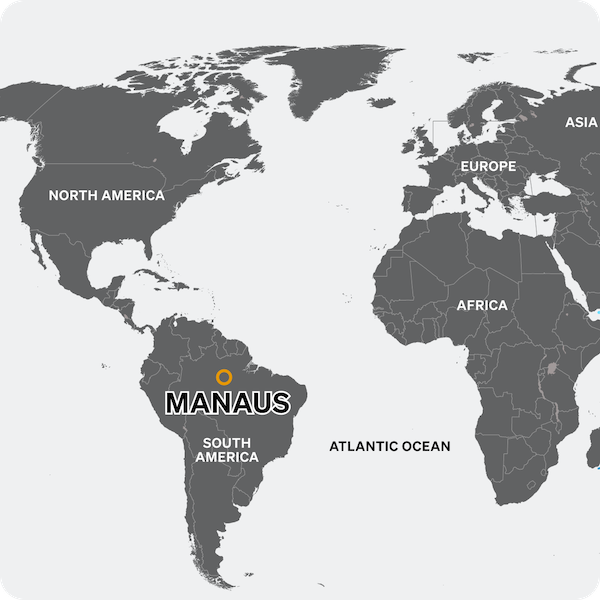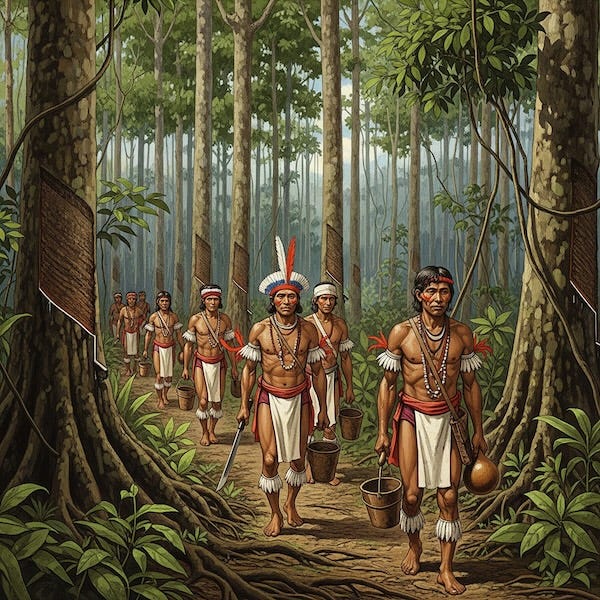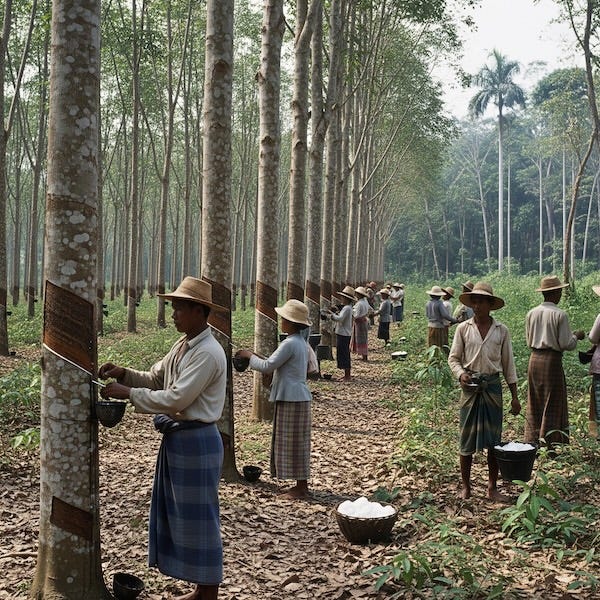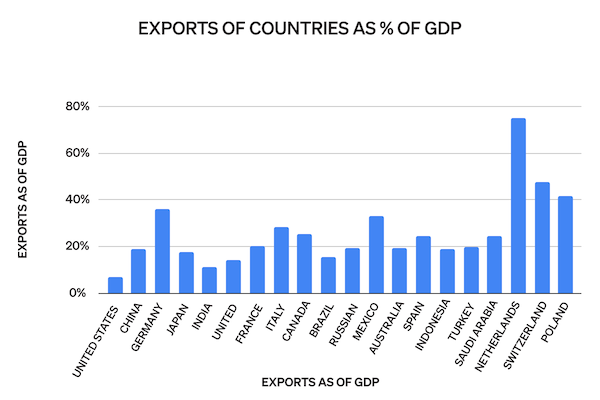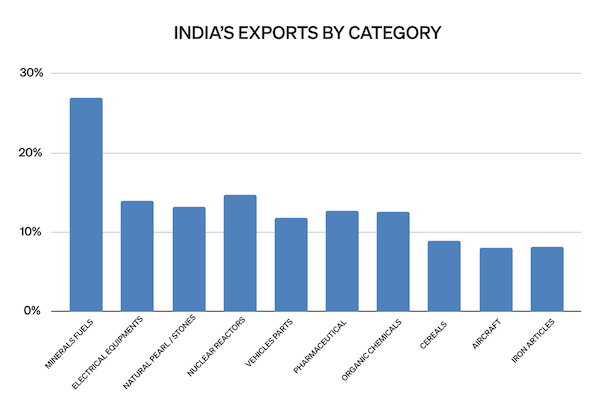In Brazil, there is a city that should not exist.
A city in the middle of nowhere – it had no roads connecting it to other cities.
It was on the banks of a river so wide, the city had a sand beach.
And yet, this city does exist: Manaus.
Right in the middle of the Amazon forest, surrounded by deep rainforests that run for hundreds of kilometers.
How did Manaus come to be?
Birth of Manaus
In the 1600s, the Europeans were taking their ships and exploring the world. In the process, they colonised many regions.
One Portuguese ship ended up in the Amazon river.
Between incredibly dense and thick rainforests, the Portuguese decided to set up a military outpost. This was done to protect their interests in natural resources in the region.
The surrounding forests were dense with flora and fauna: lizards, venomous snakes, crocodiles, meat eating fish, birds, mosquitoes, jaguars, even venomous plants and fruits.
The area was inhabited by various small tribes who had remained uncontacted by the outside world.
This military outpost grew and became a fort.
The fort evolved to become a town as some local tribal people moved for various benefits.
For a couple of hundred years, things continued as they were.
The small city of Manaus grew bit by bit, until something changed in Europe.
A New Resource
The native inhabitants of South America had been using rubber for many millennia. They found a 3,000-year old rubber ball showcasing one of its earliest uses.
Why had other regions not used rubber all this while?
Rubber was obtained from the sap of a tree. This tree was found only in the Amazon forest. Once the Europeans reached this region, they took some rubber with them.
But this was of no significant use.
An entrepreneur named Charles Goodyear accidentally dropped rubber and sulphur into a hot stove. This resulted in vulcanised rubber.
Thanks to this accidental discovery, the use of rubber expanded globally.
Only a couple of decades later, around 1860, the bicycle was invented.
With that invention, the demand for rubber shot through the roof. The world bought more bicycles. Their tyres needed rubber. The world needed more rubber.
And the rubber was only found in… the Amazon forests.
The city of Manaus became a hotspot of rubber trade.
Tribal people used to go into the forests, cut grooves in the rubber trees, and let the rubber sap drip out.
Once they had done enough of that, they carried the sap and sold them to traders in Manaus.
This was an entirely wild operation. There were almost no rules, laws, or regulations.
This meant that some traders became powerful. They started hiring labourers to work for them, to go deeper in the jungles looking for rubber.
Some started to take over the wild forest land and marked territories. These were still mostly wild rubber trees growing among other foliage.
These powerful rubber traders or barons became incredibly wealthy.
The other side of this wealth was workers who faced horrible working conditions, slavery, unpaid wages, sickness, torture, and even death.
It was without a doubt a complete violation of human rights.
From the 1870s, for about 50 years, the Manaus-based barons’ wealth grew to astronomical levels.
The city became the highest per-capita consumer of diamonds in the world.
Men would feed their horses chilled champagne. Food would be imported from across the Atlantic Ocean, from countries like Portugal.
Women sent their clothes to Europe for laundry because the Amazonian waters were too muddy.
Grand theatres, hotels, hospitals, and electricity lines were erected.
Mind you, at this point in time, the city of Manaus was still connected to the outside world by only the river. No roads reached the city.
It was a grand city in the middle of the rainforest – with just wilderness for hundreds of kilometres on all sides.
Theft & Spread
The region had a monopoly over the supply of rubber to the entire world.
It made the barons of Manaus very rich. They were selling rubber to the entire world. Without rubber, the city could not have grown anywhere near as rich.
Monopolies are great for sellers. But they are horrible for the buyers.
Europe, among other parts of the world needed more rubber — and for cheap.
The invention of cars meant even more tyres would need to be made.
Brazil was being cautious. They knew the region had a monopoly because of the rubber tree. If this tree went out of their region, their monopoly would be lost.
Nature also helped them – rubber seeds that were carried on ships across the ocean never survived.
In 1876, a planter named Henry Wickham smuggled 70,000 seeds out of Brazil. Most of them died. But a few thousand seeds survived.
This small change marked the end of Manaus’ and the Amazon’s rubber monopoly.
A few thousand seeds were grown in London. London did not have the right climatic conditions for these trees to flourish.
The Europeans looked at their colonies and shortlisted regions for growing rubber.
It started with Ceylon (modern day Sri Lanka) and South-east Asia.
Once the seeds are planted, they take a few years to grow enough to be of practical use. Not many farmers were keen on it since they did not realise the market and scope.
Rubber trees take a few years to grow before they can yield sap. That made the farmers even more reluctant.
Eventually, a few years later, it was clear that this crop was a money maker.
Word spread, and the entire region took to growing rubber trees.
Since the rubber trees were grown in plantations here (and not in the wild like in the Amazon forests), they were easier to get sap out. It also resulted in better care and experimentation.
The labour was cheap and treated much better than in the Amazon forests.
In the late 1800s, Brazil supplied 90% of the world’s rubber.
This was down to 50% in 1910;
30% by 1918;
And only 1.3% in 1940.
Brazil had lost its monopoly over rubber.
The rubber barons who had grown incredibly rich in a matter of a few decades came to lose their wealth just as fast.
The lavish lifestyle dwindled and vanished.
No matter what they did to make their rubber cheaper, it just wouldn’t compete against the Asian rubber. And there just wasn’t enough demand for rubber within the region to sustain the industry.
Decades after the city lost its grip over rubber, the Brazilian government pushed to revive the city.
Today, it is still a significant player in Brazil’s economy. It still is not as significant on the world stage as it used to be in the rubber-monopoly days.
Export Economies Explained
Manaus’ economy is a classical example of an export economy.
An economy is said to be an export-oriented economy when a large part of it depends on trade from outside the country or region.
For example, South Korea is considered an export economy: about 37% of its GDP is from exports.
The opposite of that would be a country like the USA which has only about 7% of its GDP coming from export.
The advantages of having an export-based economy is big.
We saw in Manaus’ case, there was little demand for rubber within the region. It was when they were able to export it that the city’s economy picked up big time.
Exporting gives access to a much bigger market.
If you’re a car maker, you might be able to sell a few thousand cars a year if you’re selling in India. But if you can export to several other countries, you might be able to sell hundreds of thousands of cars every year.
This is one of the biggest reasons behind wanting to export.
More revenue, more profits.
Also, in the case of many businesses selling more does not lead to an increase in fixed costs (by that much). Economies of scale.
Further, there’s diversification of markets.
If your goods are sold only in one country, a factor like bad economy or a geopolitical tension can easily hamper sales — maybe even kill your business.
If you’re exporting to many parts of the world, you are less likely to be affected by one event.
These advantages are often self-reinforcing.
An export led economy becomes stronger because of better skill-development, increased innovation, higher efficiency and so on.
The advantages are too many.
Risks
There are disadvantages too; it’s not all happy-go-lucky.
Sometimes, a targeted threat can negate all the advantages of having an export-oriented economy.
What if a foreign country decides to put sanctions on your country? For whatever reason — valid or invalid.
The immediate response to this question by many is, ‘well, so what?’
Over time, export economies become export-dependent. The country’s economy, its spending, lifestyle, and habits — everything adjusts to the higher income that’s coming from outside the country.
This is what happened in Manaus.
Things start to crumble.
This is the single biggest risk.
There are many other risks but they are more manageable.
Take the case of Finland.
Back in the late 1900s, its economy was heavily dependent on the USSR for exports. When the USSR collapsed, their buyer vanished overnight.
What could they have done?
Diversification: they could have sold more to other countries also. That way, they would reduce their dependence on USSR alone.
They managed to pivot to western countries’ economies well.
Similarly, South Korea faced a lot of trouble in 1997. Their economy was heavily dependent on exports but a crisis (Asian Financial Crisis) devalued their currency. South Korean companies had taken heavy loans to expand fast into foreign markets.
These loans became a source of problems for the country as they were asked to repay and their currency was devalued (they needed more money to pay back the same amount).
There are many such examples. How do you deal with problems?
One – diversify.
Manaus’ and many other such Amazonian cities entire economy was dependent on rubber and nothing else.
So when a competitor (Asian-grown rubber) came to fight them, their entire economy came crashing.
Venezuela with oil and Cuba with sugar are similar examples.
China is famous for being the factory of the world. Recently when the USA put tariffs on the country, China did not budge.
Why?
Because the USA only buys about 15% of China’s exports. They have diversified their exports to across different countries in the world.
So, diversify what you sell, and who you sell to.
Domestic Demand
The USA’s economy is only 7% dependent on exports. The rest of the economy is because of economic activity generated within the country.
When a country’s big chunk of income comes from exports, and the exports vanish, the country suffers.
If there’s enough economic activity inside the country, exports getting hampered does not affect much.
This is why countries with a high domestic demand usually have a stable economy.
One is not better than the other. They are both better (and worse) in different ways.
When countries export, they can grow their economies faster. And therefore get richer quicker.
There is a lot of job creation, innovation, increase of strength of currency, etc.
When countries have big domestic demand, usually, it is more stable, but growth is slower. External factors affect such economies to a lower extent.
Both types of economics can have different kinds of issues with managing foreign exchange reserves.
India
India is not considered an export-oriented country. Only about 11-12% of India’s GDP comes from exports.
India is a poor country wanting to be richer.
So we do want to export more.
We want to set up more factories, make more goods, create new jobs, establish more companies, innovate and invent more.
Yes, we already do those things. But given how big a country we are, we want to export a lot more.
But the flip side of being a domestic-demand economy is that we are less affected by global factors.
There is no single country that we are dependent on for earning our livelihood. There is no single commodity or product that our economy is largely based on.
It’s very diversified.
And economic activity comes largely from within India.
Quick Takes
+ NSE agreed to pay SEBI's Rs 40.35 crore fine to settle multiple violations concerning illegal sharing of confidential information of listed companies.
+ ARCIL filed for an IPO with SEBI consisting of an offer-for-sale of up to 10.5 crore equity shares. It is the first asset reconstruction company in India.
+ The US recorded a trade deficit of $60.2 billion in June (vs $71.7 billion in May). Exports fell 0.5% to $277.3 billion and imports fell 3.7% to $337.5 billion.
+ India’s composite PMI (manufacturing + services) rose to 61.1 in July (vs 61 in June). This means economic activity grew marginally more in July than in June. Services PMI rose to 60.5 in July (vs 60.4 in June).
+ India and the Philippines announced a strategic partnership to strengthen cooperation in defense, trade, and technology.
+ Tata Capital filed for an IPO with SEBI. The IPO includes a fresh issue of 210 million shares and an offer-for-sale of 265.82 million shares.
+ Aditya Infotech IPO got listed on the stock exchanges at a premium of 50.37% over its issue price and closed 60.39% up at the end of the day.
+ The RBI decided to keep the repo rate unchanged at 5.50% to support economic growth amidst uncertainty in global trade. This comes after 3 consecutive rate cuts.
+ Prestige Hospitality Ventures got SEBI’s approval for a Rs 2,700 crore IPO.
+ NSDL got listed on the stock exchanges at a premium of 10% over the issue price and closed 17% up at the end of the day.
+ Sri Lotus Developers and Realty got listed on the stock exchanges at a premium of 18.67% over the issue price and closed 31.23% up at the end of the day.
+ M&B Engineering got listed on the stock exchanges with no listing gains and closed 6.27% up at the end of the day.
+ The US President announced 50% tariffs on Indian goods for the continued purchase of Russian oil. This comes after the previously imposed 25% tariffs which India called "unfair". India now faces the highest tariff rates among US trade partners along with Brazil.
+ China recorded a trade surplus of $98.24 billion in July (vs $114.77 billion in June). Exports grew 7.2% to $321.8 billion and imports rose 4.1% to $223.5 billion.
+ The Bank of England lowered its interest rate to 4% from 4.25%. This is the central bank’s 5th rate cut in 12 months.
+ India’s Foreign exchange reserves fell by $9.32 billion to $688.87 billion in the week that ended on 1 Aug.
+ The Indian Govt. has withdrawn the Income Tax Bill, 2025. A revised version will be introduced in the Parliament on 11 Aug.
+ The Cabinet approved Rs 30,000 crore as budgetary support to 3 public sector Oil Marketing Companies (IOCL, BPCL, and HPCL) to manage the losses from selling domestic LPG at subsidized rates.
+ Tesla has leased around 8,200 sqft commercial space in Delhi’s Aerocity for its third showroom in India. This is part of Tesla’s expansion plan to move into Indian markets.
+ Silver Consumer electricals filed for a Rs 1,400 crore IPO with SEBI.
6-Day-Course
Theme of the week: order matching
We’ve reached the end of this week’s course that started on 9 Aug (Monday). Here’s a test you should take. Get pen and paper!
Question 1:
Who matches buyers and sellers in the stock market?
-Brokers
-Stock exchange
-Banks
Question 2:
_______________ is the difference between the highest bid and the lowest ask.
-Margin
-Gap
-Spread
Question 3:
In price-time priority matching, orders are matched based on who placed the order first, and then on price.
-True
-False
Question 4:
Which type of order executes at any available price?
-Market order
-Limit order
-Stop order
Question 5:
Tick size refers to the minimum price a share can move up or down.
-True
-False
Answers:
Q1: Stock exchange
Q2: Spread
Q3: False
Q4: Market order
Q5: True
The information contained in this Groww Digest is purely for knowledge. This Groww Digest does not contain any recommendations or advice.
Team Groww Digest


